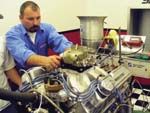
The crate engine has become a player in short-track racing. In mostcases, the track or series limits the engine selection to that of onemanufacturer, but there are a few cases where attempts are being made tobring in multiple crate engines.
One attempt is being made in the FASTRUCK Series. Promoter Bobby Diehlbrought in the General Motors' ZZ4 crate engine and decided to see whathe could do to get the other manufacturers involved. With the help ofsome willing competitors, Diehl has taken steps to find out.
Earlier this year, an engine was borrowed from teams running eachtype--Chevrolet, Ford, and Dodge. They were taken to the engine dyno ofRichards Racing Engines in Haines City, Florida. The Chevrolet went intothe cell first, followed a few weeks later by the Ford. The Dodge, whichrequired a set of headers that took some time to acquire, was last tovisit.
The idea was to get the lay of the land on the important numbers. Eachmanufacturer provides this basic information to its customers, but thosenumbers generally pertain to the four-barrel carburetor. This seriesmandates a two-barrel carburetor, so there would be some difference inthe performance numbers. The intent was to find out what needed to bedone to get the engines to perform within a few horsepower or a coupleof pounds of torque.
Scotty McLendon of McLendon Carburetors was an active participant in thetesting. His carburetion knowledge gave insight into the changes neededto get the figures in the ballpark.
The majority of the testing used the BG Fuel Systems Demon two-barrelthat was unveiled late last year. For ease of comparison, the removablesleeve (RS) model was selected. The carburetor's role in the engine'sperformance could be changed in minutes by simply pulling out a sleeveof one size and inserting a sleeve of a different size.
Chevy Test
The ZZ4 crate engine (PN 24502609) is among the most popular enginesavailable for racing. Most of the sanctions that mandate the crateengine chose the ZZ4 for a number of reasons. With the steel rollertappet camshaft (0.474-inch intake/0.510-inch exhaust valve lift), theengine made 355 hp at 5,250 rpm and torque figures in excess of 300across the range. However, that was utilizing the four-barrelcarburetor, so the figures were tossed out.
In the first test, the 500-cfm Demon two-barrel was fitted with silver(1.373) sleeves. Using 79 jets and 34-degree timing, the first test wasconducted with peak horsepower at 5,900 rpm (see Figure 1).
After the first test, the carburetor was removed to change the sleeves.The jet size was changed to a 77 jet, and the green sleeves (1.28) wereinserted. This test drew the numbers down with the engine recording itspeak horsepower of 307 at 5,700 rpm (see Figure 2).
A final sleeve change brought the red (1.4) big sleeves into thecarburetor. The jets were changed to 81. There was no change in timing(see Figure 3).
Bring on the Ford
The selected Ford engine was the M6007A351E (forged pistons). This 351ciengine was pulling 385 hp with headers and a 785 carburetor. It featureda single plane Victor Jr. intake and the 5.8L Sportsman II race block.
The BG carburetor was bolted onto this engine, which proved itself stoutright from the start. Using the silver sleeves, 78 jets, and 36 degreesof timing, it was a horsepower hero (see Figure 4).
The swap in sleeves was made to the green sleeves. In the process,torque and horsepower figures increased. The horsepower numbers keptgrowing to the 6,000-rpm range, so the peak may not have been realizedin this test (see Figure 5).
The final test for the Ford engine came with the insertion of the redsleeves. This engine showed differences, but really started picking upafter 4,500 rpm, hitting 380 hp at the 5,400-rpm range, a favorablerange for many of the competitors (see Figure 6).
The Dodge Test
After the proper headers were located and the dyno time was arranged,the Dodge (PN P5249499) was a 360 V-8 crate Magnum that advertised 380hp on the four-barrel carburetor. It is a 9:1 compression engine thatfeatures a cam profile very similar to the competitors.
As the test was underway, it was obvious there was something amiss. Thisparticular engine had some internal problems and would not be a goodrepresentation. The powerplant soldiered along to produce the numbersseen in Figure 7, but those figures have to be taken with a grain ofsalt, considering the condition of the engine.
Another Dodge was rounded up some time later, but the carburetor thathad been used on the other tests was not available. A ScottyMcLendon-prepared Holley 4412 was used to get some idea about the Dodgeperformance (Figure 8). While this is not exactly comparing apples toapples, it does give a basic understanding.
Conclusion
In a year that features elections, it's not unusual to reach theconclusion that there is no conclusion. In this case, the engines weretested to determine the possible next step or steps that the sanctionmust take. There are a number of routes that can be taken, ranging fromweight placement, mandating a particular sleeve, or changing components.It has been suggested that the GM crate engine numbers could be improvedwith a single plane manifold, used by the others. In order for this tobe accomplished, that option would have to be available at the factory;otherwise, competitors are changing the product and the intent of theexperiment.
Crate engines are expected to be mandated in 2005 for this series. Inthe meantime, officials will look at the numbers and make theirdecisions. If your series is going to offer options on the enginepackage, you can learn from others to see if this is a workable optionin your neck of the woods.